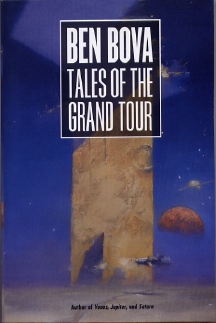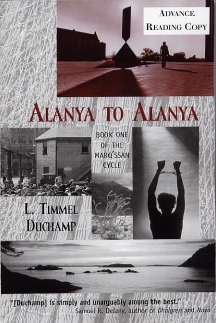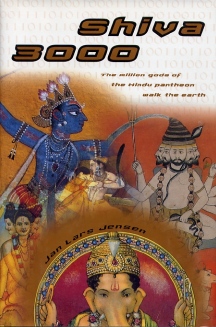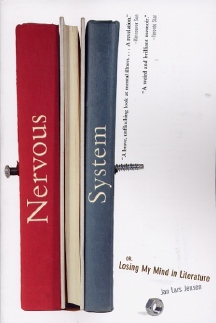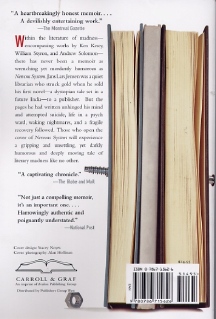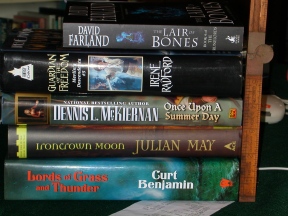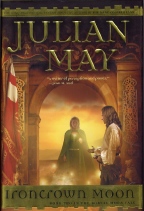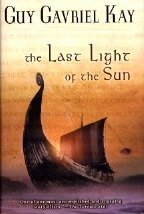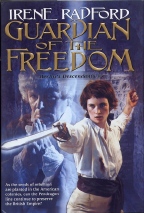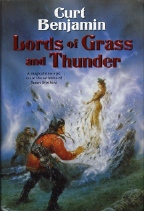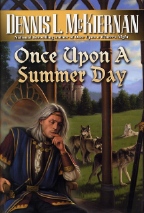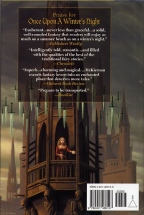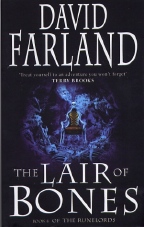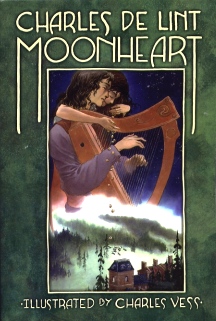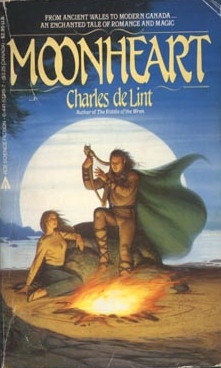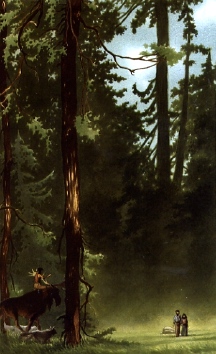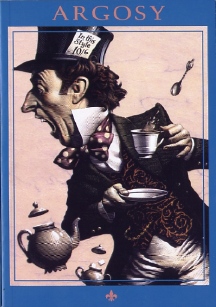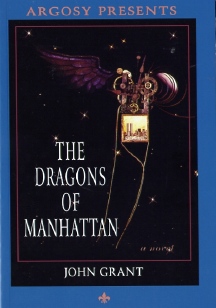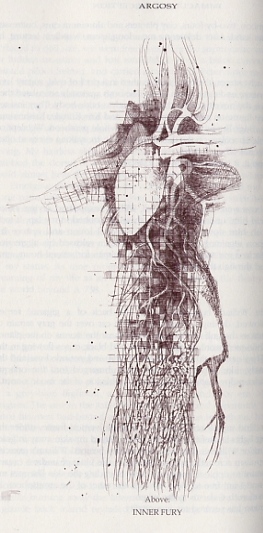|
|
|
This Just In...News from the Agony Column
|
03-24-05: 'Alanya to Alanya' by L. Timmel Duchamp |
||||||
Aliens,
Terrorists and Sleight-of-Hand Government
Last week, when L. Timmel Duchamp's 'Alanya to Alanya' (Aqueduct Press ; June 2005 ; $19.00), showed up, I thought, "Neat! A new SF series from a small press." I didn't know the half of it, or even, as it were, a fifth of it. That's because Aqueduct Press is not simply some small press I'd not yet heard about. It's the Fully Feminist Brainchild of L. Timmel Duchamp, with stellar writers on the roster, including Gwyneth Jones, Kim Antieau, Nicola Griffith, Nancy Jane Moore, Rosaleen Love and Anne Sheldon. I talked to L. Timmel Duchamp, and asked her about Aqueduct Press. She told me that it had been founded about a year and a half ago, with their first publication her short story collection, 'Love's Body, Dancing in Time'. This collection includes the Sturgeon Award nominated story 'Dance at the Edge' and the Tiptree-short-listed story, 'The Apprenticeship of Isabetta di Pietro Cavazzi'. The collection itself was also short-listed for the Tiptree award, named after famed writer James Tiptree, Junior, who in reality was Alice Bradley Sheldon. Readers who want to find out about the prize and author are urged to visit the James Tiptree, Jr. Award Website and the James Tiptree, Jr. WWW Page. As for Aqueduct Press, their mission statement reads in part, "Aqueduct Press dedicates itself to publishing challenging, feminist science fiction. We promise to bring our readers work that will stretch the imagination and stimulate thought." Well, that's pretty straightforward. But Duchamp has a lot more to say about publishing, the press, feminist science fiction and science fiction in general. For that, readers would be well advised to seek out her interview with Josh Lukin over at Fantastic Metropolis. She's a fascinating, deep and complex thinker. After 'Love's Body, Dancing in Time', Aqueduct managed to snag Gwyneth Jones' 'Life', the story of Anna Senoz, a scientist who makes a momentous discovery about the X and Y chromosomes. Obviously this has some sexual implications that don't sort out easily. Jones is one of those award-winning authors whose work one expects to find only in New York hardcovers. That it shows up here is an argument in favor of the good taste of Aqueduct Press -- and their good fortune in snagging the title. All this leads us back to 'Alanya to Alanya', the first novel in Duchamp's five-book series 'The Marq'ssan Cycle'. I have to admit, I was wary at first. When I see the announcement of a five book series, I'm reminded of any number of series that have started out strong, with an apparent end in mind, but faltered along the way, either because the writer lost their way to the perceived ending or because the publisher lost the will to publish the books. That's not the case with the Marq'ssan Cycle. In fact, it was first finished in the late 1980's, but as Duchamp tells us, "The Fall of the Soviet Union, the media's declaration that feminism was finished, and the continual and apparently unmourned erosion of the US's democratic institutions convinced me that that it would likely be unintelligible to most readers...A decade later I returned to the manuscript...to find...the "bad place" I had imagined uncomfortably close." Alas, because the books weren't published when they were first written, they could not prevent the dystopia they foresaw. Duchamp tells me we can expect the subsequent volumes to show up on an annual basis, or perhaps more often, if demand warrants. I'm holding book one in my hands, and I've got a page showing me the titles and synopses of the following four books. We've got cover designs, courtesy of Duchamp's long-time associate and Aqueduct's managing editor Kathryn Wilham.
The second novel, 'Renegade', takes place a year later. Civil war is consuming the US, and Zeldin leaves the semi-safety of the Pacific Northwest Free Zone to determine the fate of some missing scientists, eventually coming face-to-face with the head of the Security Services she once served. Book Three, 'Tsunami', springs forward nine years to 2086 and a world recovering from civil war. The Free Zone's Co-op faces a crisis as the US Executive tries to consolidate its power. Book Four, 'Blood in the Fruit', finds an enclave in the Free Zone that may not be what it appears to be, while Book Five, 'Stretto', finds the Free Zone thriving and a takeover of the remainder of the US imminent. At four hundred plus pages, 'Alanya to Alanya' is a pretty hefty chunk of literature; all five books top a million words. So the question is, "What's going to pull the reader through this series of hefty books?" The answer is a pulse-pounding alien invasion plot and a philosophical underpinning that screams bloody murder at the current direction of our nation. Duchamp tells readers in an Afterword that she'd seen plenty of workable feminist utopias, plenty of plausible dystopias, but few visions of the process to go from one state to the other. "I wanted a more direct, explicit vision of how it might be possible to change human thinking as well as social and political interactions." I'd like that as well, and I'm going to enjoy it even more if it includes nasty US Executives duking it out with crypto-terrorist aliens here to give humanity a comeuppance. |
|
03-23-05: Jan Lars Jensen, From 'Shiva 3000' to 'Nervous System' |
|||||||
Broken
Gods and Broken Minds
I was something of a fan of the publisher at the time, giving them a lot of credit for bringing Lem after Lem. So I picked up this one, and reading it was something like pouring a red-hot bowl of curry over my head. Jensen's tale was a hallucinatory vision of Gods made real and unreal, of a society where technology had become an entity unto itself -- and then become very ill. Two men, a warrior reborn on a task he is forced to pursue, and an Engineer who can see into the heart of the machinery that sees itself as gods, journey through a landscape that is confusing, antagonizing, utterly original and brilliantly bizarre. "Sometimes from separate threads comes a picture." Jensen wove together tales within tales, folklore, steampunk, and every religion he could lay his hands on into a compelling adventure that was filled with glossy, mind-boggling action yet underpinned with some thoughtful digressions on the nature of belief, technology and self-image and religion. It was utterly unlike anything offered by horror, fantasy or science fiction. Heady pre-millennial stuff. But in the post-millennial celebrations that followed, Harcourt all but retired its science fiction line, and readers waited in vain for Jensen's second novel. And waited. And waited.
But literature, which had led to his breakdown, would also lead to his recovery. 'Nervous System' describes Jensen's attempts to understand the animal stories of James Herriot through a haze of anti-psychotic medications (I confess here that I loved the UK series based on Herriot's work starring Peter Davison), his psychiatrist's references to the novels of Patrick O'Brian and his own attraction to a history of logging which he used to bring himself closer to sleep. And here's the reason you're reading this column now. You wouldnt find this in the science fiction section of your bookstore -- if you'd find it at all. Non-fiction readers wouldnt know what to make of it -- though the cover image would surely draw your attention. If you come to the Agony Column for a hint where to look and what to look for, today, you've come to the right place. 'Nervous System' is just the kind of book that you'd want to find but that might get away. Dont let it get away now! You can scare up a pristine copy of 'Shiva 3000' for $24.00. My suggestion would be to grab one of those, immerse yourself, and then follow the same trail that Jensen himself followed, through the harrowing world of mental illness, through literature high and low and out the other side, to a fragile peace and place in this world. Most of us feel pretty good about our place here, and few of us worry that we might bring about the end of the world. Probably more of us should, and if it has to happen, I for one would not be averse to seeing Shiva set things right. |
|
03-22-05: David Farland 'The Lair of Bones', 'The Last Light of the Sun' by Guy Gavriel Kay, Irene Radford 'Guardian of the Freedom', Dennis L, McKiernan Once Upon A Winter's Night, Julian May Ironcrown Moon, Curt Benjamin 'Lords of Grass and Thunder' |
||||||||||||||||||||||||||||||
Doorstops
on the Doorstep
The merchants of fantasy have gotten pretty smart about it as well. Realizing that there are all kinds of people out there, they offer readers all kinds of fantasies. There's the horror-tinged adventure, the romance tinged historical adventure, the far-Eastern adventure, the straight-up historical fantasy, and your traditional bickering politicians fantasy, apparently for those who want all the comforts of fantasy but don't wish to stray too far from the underlying aspects of OMW. Let me be your guide as you choose your escape route.
Once again, I read May's prose, and it's really quite nice. Obviously, the audience for this one has already read book one, and is hot-to-trot for book two. May has a long resume in the SF&F field, which guarantees an audience. And the profits from this book will help to float a novel or two by some unknown author who deserves to be heard. So, if you're up for the bickering politicians, our world through a fantasy filter with some pretty carefully turned prose, a sort of fantasy page turning political thriller, go back to square one -- 'Conqueror's Moon', and you can have this one all lined up. Note the fine cover by Steve Stone, last seen doing Steven Erikson's novel 'Deadhouse Gates'. We've written about, reviewed and enjoyed immensely the straight-up historical fantasy by Guy Gavriel Kay, 'The Last Light of the Sun'. (Ace /Penguin Putnam Trade Paperback ; April 2005 ; $14.95). It's now available in a trade paperback, and if you're at all inclined to read fantasies, here's a great place to start at a very decent price. Cover art, even type size are preserved, so dont hesitate. Pick this one up and you can get your historical fix with more than a touch of class. Irene Radford's 'Guardian of the Freedom' (DAW /Penguin Putnam ; April 2005 ; $24.95) offers another historical fantasy with more than a hint of romance. Here's the spin of Radford's series; she's writing fantasies that follow Merlin's Descendants through the ages of British history. With Book five, we're at King George III, who has little use for Drake Kirkwood, the current Pendragon and magical scion. Drake, suffering in health, has come to rely up the unreliable, and his rebellious sister Georgina is off in the colonies. I've got to mention that it really looks like they've got John Pertwee of 'Doctor Who' fame fading out there on the cover. But I can authoritatively say that there is no TARDIS in this tale. I'm guessing that Georgina dons a boyish disguise, impresses some 'murricans in the Colonies and gets caught up in a certain revolution wherein her true sex is reveled to the great relief of the gents who found that soldier strangely attractive. You do have one of the few fantasies I've ever seen to bring the forces of chaos to the American Revolution. That's a pretty interesting spin, and probably why she gets these books printed. The prose is straightforward page-turning bestseller style stuff. 'Guardian of the Freedom' looks like it is quite able to erode your reality while deftly building its own. No, Curt Benjamin's 'Lords of Grass and Thunder' (DAW / Penguin Putnam ; April 2005 ; $24.95) is not about Hell's Angels. What you have here is a standalone follow-up, wait -- what the hell do I mean by that? Simply put, this is a book that follows up characters created in other books but has a fairly self-contained plot of its own. Gods, check, warriors, check, princesses, check, demons, check dark magic, check. This one hits on all fantasy cylinders with a bit of a Far-eastern twist. The cover, by Luis Royo, has a certain amount of space that I like. A fair number of monsters, albeit of the demon/revenant variety, definitely lots of swords, inexplicably left out of the checklist, family trees, military structures, and prose that gets you there. If you're worrying too much about matters in the Far East, then here's something to distract you. Hey lookit over there, some magic. Made you look! And damn you were happy to look, 'cause you didn't have to see what you stepped in over here. I'm lookitin' over there as hard as I can. Dennis L. McKiernan's 'Once Upon a Summer Day' demonstrates that no idea can be recycled too many times. Now, I really enjoyed Gregory Maguire's 'Mirror Mirror', which, in movie parlance, "re-imagined" Snow White in sixteenth century Borgia-ruled Italy. McKiernan pulls a similar stunt here, with 'Sleeping Beauty', following up his own 'Once Upon a Winter's Night'. So, once, etc, Prince Borel dreams about a gal in a tower surrounded by swords. Twice. Three times. He gets the message and sets out on the quest. Readers who like their prose light and humorous and their opening chapters extremely short should sign up for this one. Yes, the chapters get longer as the book comes to a close. But I dont think the prose gets any heavier. The Borel shown in the cover art by Duane O. Meyers looks a little bit long in the tooth to be going on any quests, and if he's of the age that involves dozing off in the sun, well, that doesn't peg him for spring chickenhood either. McKiernan is not taking Maguire's rather artistic approach to retelling the classics. Instead, you get a more traditional bestseller fantasy approach to the children's classics, though I suspect this one stays firmly PG territory. Movie parlance again, huh? I guess that should be taken to tell us something about this book, then. And finally, over the UK, theyve aimed a shrink ray at the fourth volume in David Farland's Rune Lords trilogy, 'The Lair of Bones;' (Pocket Books / Simon & Schuster UK ; April 4, 2005 ; £6.99). Should you be a reader of horror who seeks some fantasy to spice up your reading life, this may be just the treat you seek. Everything's in ruins and reavers from the underworld are having a field day. Yes, this is a fantasy and not more nonfiction. You've got some underground ancient evil and even a glossary, should you have forgotten that a Frowth giant is "One of several types of giant in the known world, the frowth is the largest, standing nearly seventeen feet tall. The frowth is covered with long silver hair. The frowth is omnivorous but favors meat. Though unable to communicate with humans well, the frowth sometimes allow themselves to be hired as laborers or mercenaries." By Wal-Mart, presumably, as theyre likely averse to unionization. But given that theyre defined in the Glossary, theyre likely covered in the text, which translates to: guaranteed monsters. In fact, this looks like a pretty monsterific fantasy. Get the drool cup, sire. Rick read fantasy. Grrrr. Arrrgh. Strange times indeed. Choose your poison, but don't come after me should you suffer any ill effects. This is a no-warranty column here. For while I desperately seek escape from the real world, I also find myself forced to live within its confines. Until I can pull a sword from a stone that will once and for all slay the bills that await me in the mailbox. Where's that sword? This is what happens when you live in an economic fantasy. It's a lot more common than we'd like to admit. |
|
03-21-05: Charles De Lint's 20th Anniversary Edition of 'Moonheart' and Argosy 3: Spring 2005 |
|||||||||||||||||||
Two Splendid Reasons to Buy Books
Abandon all money, ye who enter here. The question you're going to ask yourself first is: "Where was I when 'Moonheart' first came out?" Pre-school? Junior High? Just married? Take your pick, I wont tell. That fat, 485 page Ace paperback was one of the first books in my then-nascent book collection. I had three bookshelves embedded in the wall behind the couch in our Spanish bungalow three blocks from Redondo Beach. I was working at the book factory back then, and we'd had a 1984-themed New Year's Eve party for which I supplied most attendees with full-body disposable isolation suits. Oh the joys of reckless, feckless youth. Do they withstand the test of time? Given that I recently enjoyed De Lint's 'Spirts in the Wires', I guess so. Along with De Lint, I had Clive Barker, Stanislaw Lem, hardcover H. P. Lovecraft and a good arm's length of Philip K. Dick. Roger Zelazny's 'Doorways in the Sand'. 'The Lord of the Rings', 'Gormenghast'. Edward R. Whittemore. And 'Moonheart'.
I can look back on the period of discovery, and my ancient Ace paperback with great fondness. But reading the Ace book is another matter entirely. And so up pops Subterranean Press to do the job so right you could barely form the wish that might bring such a book to pass. Not only is 'Moonheart' (Subterranean Press ; May, 2005 ; $75/Limited, $125 Deluxe/Limited) getting a cloth binding and a wonderful introduction by Charles De Lint. That in itself would be reason for joy. The jumping would be occasioned because this new edition is illustrated and illuminated by long-time De Lint collaborator Charles Vess.
De Lint assures us in the introduction that's he not done a lot of revision, just a bit of sharpening, because, "I'm not the same person as that young self...It strikes me that it would be unfair to play with his vision." Does it matter where you were when you first found 'Moonheart', when it first came out? No, not really. All that matters now is that you can get the optimal version of genre classic, signed, cloth-bound, and illustrated in color. At least this time, not only will the content withstand the test of time; the volume itself will. 'Moonheart' has found a worthy vessel. And were one to speak of worthy, it seems that we're not worthy of what James A. Owen is currently doing with Argosy Magazine. Issue number three is out now, and thank the fates it lives up to my gushing back-cover blurb and the cover price of $20.00. Seeing that text on the back cover, I must admit I was apprehensive that the contents would not live up to my previous praise. Silly me. This issue is even better.
The cover illustration is by Mark Summers, a beautifully rendered pseudo-Victorian print that match the pseudo-Victorian tone of the book itself. Joan Hall provides the cover for this issue's novel excerpt -- more on that in a moment. The interior illustrations are by no less than Bill Sienkiewicz, last seen illustrating Richard Morgan's script for the Black Widow. And there are lots and lots of illustrations by Sienkiewicz, in a variety of styles, carefully laid out and included to maximize eye-value without interfering in reading pleasure. This is important. The book is printed in dark brown ink on light brown paper, keeping with the pseudo-Victorian-ness of it all. As with previous issues, there's a mix of non-fiction and fiction here, thought he emphasis is on fiction. Even the non-fiction is of the sort that would appeal to readers of fiction. William F. Nolan offers the "far less glamorous truth" on 'The Night Dillinger Didn't Die'. At least stripping away the slick allows the bad guy to have the last laugh. Fiction includes: 'Accident of the Year' by mystery writer Christopher Chambers, 'The Telephone' by Zoran Zivkovic, 'Chase and the Missing Man' by Richard A. Lupoff (which nods to the Dillinger theme), Steve Rasnic Tem's 'the Carving', 'Immaculate Perception' by Chris Nakashima-Brown, 'Serpent's Dance' by Jim Fusilli, 'Still Life with Action Figure' by Charles Coleman Finlay, and 'An Incident at Agate Beach' by Marly Youmans. There's a variety at work here but also a certain consistency in tone that makes it clear that Owen is offering no less than an illustrated wonderfully-designed anthology.
'The Dragons of Manhattan' is more about the ways in which the herd of humans is being, uh, copulated over by those in charge. Among other things, all of them designed to stimulate wonder, anger, and laughter in equal parts. Grant writes with the kind of illuminated fury that makes reading really fun - and rewards the person who popped for this fine, fine magazine. These two publications -- novel and magazine -- both offer superior prose, superior presentation, beautiful art and squeeze every last drop out of what you can do with printed books. Should you decide to part with your money, chances are, in twenty years, you will feel both glad you spent the money now -- and willing to spend it again on subsequent editions, produced in a world that is, at the moment, pure fantasy. |
